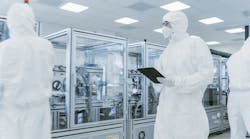"Single-use devices have clearly reached mainstream acceptance in the industry,” concluded BioPlan, after reviewing the results of their Annual Report and Survey of Biopharmaceutical Manufacturing Capacity and Production.
According to BioPlan’s survey, almost 90 percent of respondents continue to use one or more single-use device at some stage in bioproduction (R&D through commercial). The most common uses were in tubing, disposable filter cartridges, and connectors and clamps.1
This should come as no surprise to the industry, as these single-use technologies offer distinct advantages compared to traditional, fixed stainless steel systems in terms of cleaning and validation. This can lead to a positive environmental impact by reducing the use of resources such as water and energy. Single-use options can also reduce the time and investment required to get facilities and process lines up and running.
But these advantages must be balanced against new operational challenges, chief among them, waste management and disposal.
The adoption and growth of single-use technologies in biopharma manufacturing is significantly increasing the amount of plastic waste being generated. It’s estimated that by 2025, biomanufacturers will be producing 112,000 tons per year of plastic waste, globally.2
DISPOSAL OPTIONS
Biopharma facilities produce different categories of waste: non-hazardous, hazardous, regulated medical waste and biohazardous. EPA regulations define what is considered hazardous and the Department of Transportation regulates how waste is handled and transported.
The industry standard for years has involved landfilling or incineration, depending on the type of waste. Biohazardous and regulated medical waste disposal typically involves contracting with a company authorized to contain, transport and dispose of this waste. Biopharma companies perform robust risk assessments to determine the right disposal options. Not surprisingly, many companies err on the side of caution, even going as far as choosing to autoclave waste before allowing it to leave the facility or labelling waste as biohazardous whether it is biohazardous or not.
But the increase in single-use plastics waste is pushing biopharma companies to address the environmental impact of these currently utilized methods of disposal, and question whether there is a better option.
RECYCLING PLASTIC
While recycling seems like an easy solution, there are challenges that arise when it comes to recycling single-use technologies in biopharma. Most standard recycling programs cannot accept biohazardous or medical waste without it first being sterilized. Additionally, many single-use products used in biopharma facilities are made from multiple plastics and materials — and standard recycling programs are not equipment to handle separating these materials.
Perhaps the biggest hesitation has to do with traceability. The traditional recycling infrastructure does not allow for traceability.
“It makes sense that biopharma customers are very concerned about losing track of where plastic waste goes once it leaves their facilities. Obviously, they want to make sure that their waste is properly disposed and that nothing happens that isn’t supposed to in the process,” says Jacqueline Ignacio, global manager, Customer Sustainability Solutions, MilliporeSigma.
Ignacio points out that human rights are also a concern, given that labor violations are not uncommon in facilities that process plastic waste abroad.
“If you are a company making products that better people’s lives, it would be contradictory for your trash to be doing the opposite,” says Ignacio.
FINDING A SOLUTION
MilliporeSigma estimates that a single biopharma site produces about 12.5 tons waste per month that is eligible for recycling. As a leading supplier of single-use biopharmaceutical products, including single-use bags, tubing, connectors and filters, MilliporeSigma recognizes the need to reduce the environmental impact of its products.
In 2015, MilliporeSigma launched an exclusive partnership with Triumvirate Environmental in order to enable bioprocess manufacturing customers to fully recycle plastic single-use and disposable products.
Triumvirate’s innovative program can utilize the entire product in its recycling process, without requiring segregation or disassembly. Triumvirate can accept regulated medical and biohazardous waste, as well as non-hazardous waste such as hairnets, gloves and gowns. The waste is shredded and sterilized in one step, and turned into landscape timbers, construction materials and plastic shipping pallets at Triumvirate’s Pennsylvania facility.
“Having biopharma waste processed in the same facility that is manufacturing the next product completely takes traceability issues out of the equation. Biopharma manufacturers know where their waste went and what it was transformed into,” explains Ignacio.
MilliporeSigma and Triumvirate are currently working with 11 biopharma customers, including Johnson & Johnson’s Janseen site in Malvern, PA. Johnson & Johnson’s reports that through this program alone, 50 tons of single use technologies were recycled last year.
IT'S NOT WASTE, IT'S OPPORTUNITY
Despite an impressive start, single-use technology recycling is still in its infancy in the biopharma industry. The MilliporeSigma/Triumvirate partnership is the only one of its kind in the industry and is focused primarily on East Coast facilities. As global disposable plastic production continues to exceed the ability of waste management to keep up, recycling is becoming imperative.
“This is just the tip of the iceberg for recycling processes. There’s a whole economy surrounding plastic recycling that we’ve only just started to tap into,” says Ignacio.
What’s it going to take to make this happen in pharma? For starters, collaboration between waste management, single-use suppliers and biopharma companies, yielding programs such as the one put in place by MilliporeSigma and Triumvirate.
“My hope is that this gets people looking at waste differently and realizing that it’s not just single use. It can become another product, safely and affordably. Eventually people will start to look at waste not as waste, but as a feedstock for something more,” concludes Ignacio.
REFERENCES
1. BioPlan’s 14th Annual Report and Survey of Biopharmaceutical Manufacturing Capacity and Production, April 2017.
2. YouTube, “Millipore Sigma Tech Talks: Biopharm Recycling Program.” April 2018.
[javascriptSnippet]







